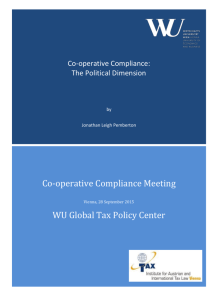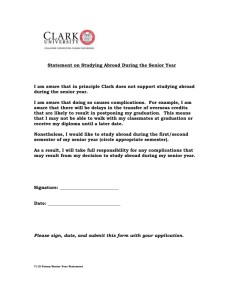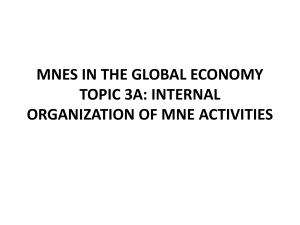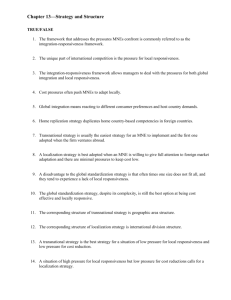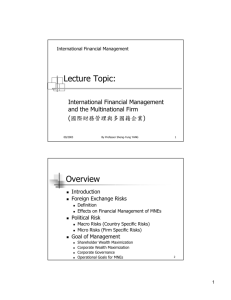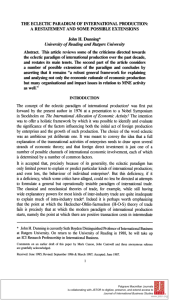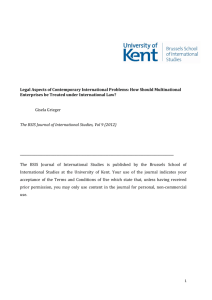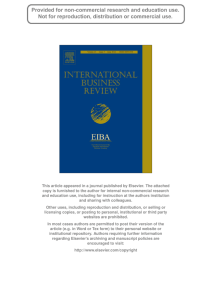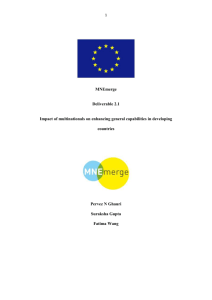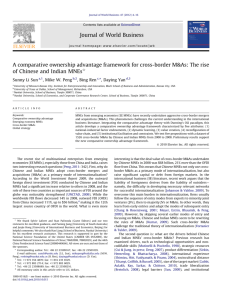International Business MGT 440 Section 01 Quiz # 1 .
advertisement
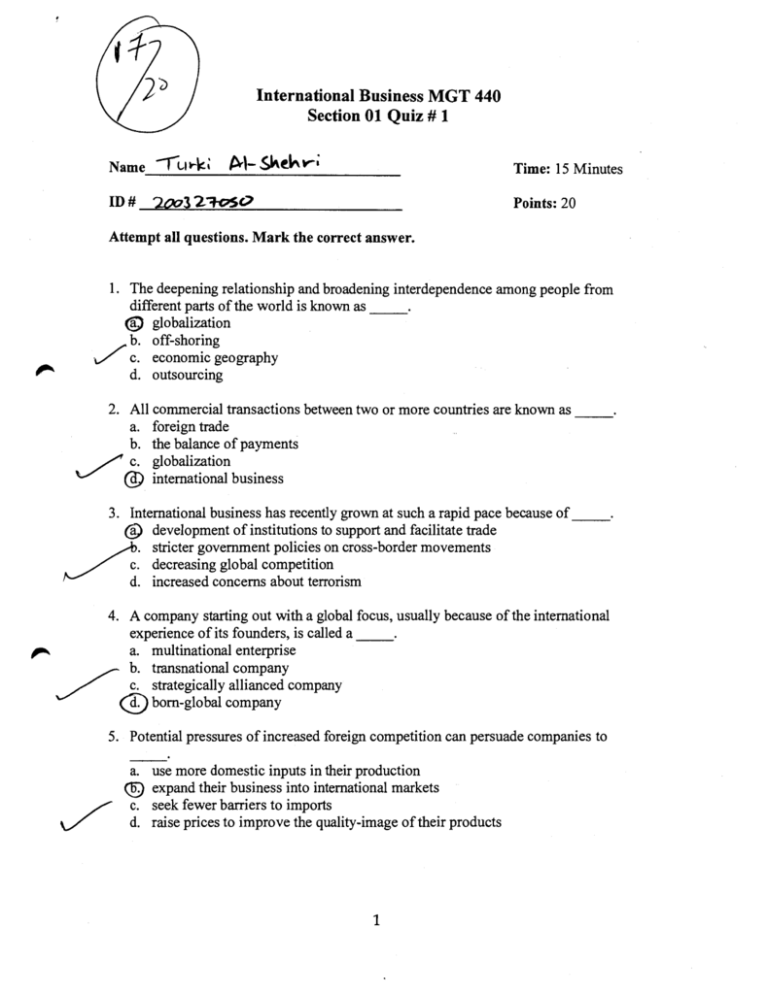
International Business MGT 440 Section 01 Quiz # 1 Time: 15 Minutes Points: 20 Attempt all questions. Mark the correct answer. 1. The deepening relationship and broadening interdependence among people from . different parts of the world is known as @ globalization b. off-shoring c. economic geography d. outsourcing J F /: P 2. All commercial transactions between two or more countries are known as a. foreign trade b. the balance of payments c. globalization international business . 3. International business has recently grown at such a rapid pace because of @ development of institutions to support and facilitate trade stricter government policies on cross-border movements decreasing global competition d. increased concerns about terrorism . 4. A company starting out with a global focus, usually because of the international . experience of its founders, is called a a. multinational enterprise b. transnational company c. strategically allianced company d born-global company 0 5. Potential pressures of increased foreign competition can persuade companies to a. use more domestic inputs in their production @) expand their business into international markets c. seek fewer barriers to imports d. raise prices to improve the quality-image of their products 6. All of the following are major criticisms of globalization except . a. countries lose control to act in their own best interest b. globalization brings economic growth that uses too many nonrenewable resources and despoiIs the environment /c. globalization creates winners and losers, thus leading to greater inequality @ globalization increases the cost of production 7. The process of shifting production from a domestic to a foreign location is known as out-sourcing c. service imports d. a turnkey operation 8. The major argument companies use to support off-shoring is that it . a. helps poor countries improve their economies saves costs reduces pollution. d. reduces home-country unemployment 9. When two or more organizations share in ownership of a foreign direct investment, . the operation is called a a. portfolio investment b. transnational corporation c. turnkey operation @ joint venture 10. A multinational enterprise (MNE) is one that is . a. among the world's 500 largest companies b. owned and managed by companies whose headquarters are split among different countries c. licensed to operate by the United Nations Transnational Center @ willing to consider market and production locations anywhere in the world 11. consists of specific learned norms based on attitudes, values, and beliefs of a group of people. A c $ s : n d. Doctrine International Business MGT 440 Section 01 Quiz # 2, March 19,2009 Name ID # AU AA P / ~ L ~ L ~ 2b0 3 5 38?O Time: 10 Minutes Points: 10 Attempt all questions. Mark the correct answer. 1. The idea that endorses the principle that an individual has the freedom to pursue his . or her interest, even at the risk of threatening the common good, is called a. socialism b. totalitarianism 2. -refers to a political system in which government is organized by and accountable to the people. a. Totalitarianism a Socialism Democracy sg 3. The form of government whereby a single person, political party, or organized group has absolute control over all facets of life in the country is called a system. capitalist totalitarian democratic d. socialist fi 4. The four major forms of totalitarianism are . @ authoritarian, fascist, secular, and theocratic b. democratic, liberal, theocratic, and vigilante c. secular, communal, tribal, and neoconservative d. communist, theocratic, feudal, and authoritarian 5. A theocratic totalitarian government is a . a. system under which all resources and production are controlled by the government b dictatorship led by a religious group c. government in which many people participate in the decision-making process d. dictatorship that does not have any affiliation with I-cligiousgroups or precepts J" 6. The chance that political forces change a country's business environment in ways that lead investors to lose some or all of the value of their investment or be forced to accept a lower than projected rate of return is referred to as . a. governmental risk b. operating risk c. transaction risk political risk 7. The of a country outlines how authorities will regulate activities, such as the investment of capital, custom duties applied to imports, or transfer of hazardous waste, as well as routine activities such as the payment of dividends to foreign investors. a. political system legal system civil system d. economic structure A 8. A system of law based on a very detailed set of laws organized into a code is commonly referred to as . a. an autocratic legal system a common law system a civil law system d. an administrative law system 9. Laws on local business activities directly influence the operations of domestic and foreign companies in areas such as . a. ethical standards and consumerism ideals environmental standards and critical social issues any issue that directly alters the well-being of local communities @ employment practices, contractual relationships, and business formation 10. refers to the creative ideas, innovative expertise, or intangible insights that give an individual, company, or country a competitive advantage. Proprietary goods Exclusive ownership Restrictive goods @ Intellectual property International Business MGT 440 Section 01 Quiz # 3, April 7,2009 Time: 10 Minutes Points: 10 Attempt all questions. Mark the correct answer. / P' I"0 / 70 1. Which of the following statements reflects the impact of MNEs on host counties? a. Because of the large size of MNEs in terms of revenues, host counties do not have the power to influence their policies. @ FDI seems to have the greatest impact on host counties, although other forms of doing business abroad can also have an influence. c. Although a few MNEs have large revenues, their revenues are not significant compared with the GNL of most countries. d. Local pressure groups have given up devising policies to restrict MNE movements and are more interested in how to let them do what is necessary to be profitable. 2. To survive, a company must ultimately satisfy which of the following stakeholder groups? employees b. family members c. competitors d. advertisers a /< / / 3. Which of the following statements is true regarding the potential economic effects of MNEs? a. FDI brings only capital inflows to the host country. b. MNEs' investments are initially favorable to the home country and unfavorable to the host country. c. Host country restrictions on capital outflow increase confidence in the economy and encourage MNEs to invest in the host country. @ The effects of MNEs on growth and employment are not a zero-sum gameboth counties may benefit. 4. Opponents of FDI link the actions of MNEs to which of the following consequences? a. political stability @ inkquitable income distribution c. preservation of the environment d. societal prosperity 5. In what ways can FDI benefit the host country? through the transfer of technology and capital and the creation of new jobs b. forcing local companies to pay higher wages to their laborers c. destroying the local entrepreneurial spirit d. exploiting natural resources and polluting the environment a <'/ /' 6. In what way can MNEs harm the host-country economy? a. encouraging new local entrepreneurs b. transferring new technology to the host country c. borrowing money in the host country at higher interest rates a& preventing the host country from enjoying the economic benefits of the innovations developed by its residents 7. A manager who refuses to bribe customs officials in a foreign country even though it is morally acceptable in that country believes in . a. relativism normativism c. humanism /" d. existentialism /. ,8. What is the Kyoto Protocol? a. It is an agreement that requires all members of the United Nations to reduce their greenhouse gas emissions by 5.2 percent. b. It is an agreement between the United States and Japan requiring both countries to control greenhouse gas emissions more tightly. It is an agreement that requires the signatory countries to cut greenhouse gas emissions to 5.2 percent below 1990 levels. d. It is an agreement that requires each country to report its emissions levels each year. 9. /' / -teaches that "people have a responsibility to do what is right and to avoid doing what is wrong." a. Moral courage b. Implied normativism @ J Ethics d. Cultural relativism 10. Bribery payments . a. must always be in cash b. are always paid directly to government officials can include anything of value d. are never made via intermediaries $% J International Business MGT 440 Section 0 1 Quiz # 4, April 19, 2009 / Name ID# 7-3 5 3 2 A Time: 10 Minut Points: 10 Attempt all questions. Mark the correct answer. 1. Why should managers in international business understand internationa trad P C/ 8 ~ ~ n t r itrade e s policies, based on trade theories, influence which pr& companies might export to given countries. b. The understanding helps managers decide whether their companies should follow laissez-faire management practices. c. The theories help managers decide whether to locate production in large versus small countries. d. The comprehension is useful when deciding whether to transfer managers abroad to manage foreign operations. 2. The trade theory that premises a country's wealth is measured by its holdings of treasure, usually in gold, is known as . @ mercantilism b. the Porter Diamond c. monetarism d. bullionism d 3. Nine of the top 10 exporting countries are countries with a. cheap labor b. small land masses c. dependence primarily on raw material exports @ high incomes per capita v' P . . a. between high-income countries and low-income countries @ among I high-income countries c. among low-income countries d. between raw material exporters and manufacturing exporters 4. Most world trade takes place , C/ J 5. Low-income countries have their best export advantage in which stage of the product life cycle? a. growth b. maturity @ decline d. introduction 6 . Brain drain is a term to describe . @ the loss by a country of productive human resources b. having three examinations in one day c. the exportation of products embodying high-technology in exchange for lowtechnology products d. the unauthorized use of patents and technology /'- 7. The term protectionism when applied to international trade refers to . @, governmental restrictions and incentives to affect trade flows . b. payments to dock workers to prevent pilferage of shipments i/ c. border checks to prevent entry of illegal merchandise d. methods used to prevent the international spread of communicable diseases ./' 8. The rationale for the infant industry argument is that . a. incubator centers in which business, government, and academia cooperate will develop entrepreneurial companies - b. a country should give one firm in an industry a monopoly status so that it will grow large enough to be competitive internationally @ it takes time for an industry to become competitive in world markets, thus protection will allow this industry to pass the critical period d. lower restrictions should be placed on products coming from countries where a government has a large sphere of political influence 9. Import substitution is . an industrialization program promoting products that would otherwise be imported b. an industrialization policy emphasizing industries that will have export capabilities c. the quantity of imports that a given quantity of a country's exports can buy d. the protection of strategic industries 61 c/ vi 10. Exporting below cost or below the home country price is a. countertrade b. an export-led development policy a strategic trade policy d dumping 6 . International Business MGT 440 Section 0 1 Quiz # 5, May 17,2009 Name Time: 10 Minutes Points: 10 Attempt all questions. Mark the correct answer. 1. One of the biggest strategic challenges to competing in the international . marketplace is a. optimizing the sequence of tactical adjustments b. discounting cross-country differences in cultural, demographic, and market conditions c. determining how to charge the same price in all countries d. mediating pressure to offer a mostly standardized product worldwide or customizing the company's offerings in each different market 2. The industry organization (10) paradigm reports that, on average, the best predictor of firm performance is the . a. company's stockpile of assets, skills, and capabilities b. aggressiveness of a company's objectives c. consistency among a company's structure. systems, and processes d. profitability of the industry in which it competes 3. The stronger the collective impact of the five competitive forces, the a. greater the degree of stability in product innovation b. larger the number of market opportunities for c. lower the combined profitability of industry members d. greater the predictability of industry evolution 4. A strategy that focuses on lowering production costs is referred to as a a. differentiation strategy b. low-cost strategy c. cost minimization strategy d. low price strategy . . 5. The essence of a differentiation strategy is to . a. target the most sophisticated segment of the market b. incorporate the greatest number of features into a product c. be unique to a wide range of buyers in ways that support a premium price d. outspend rivals on advertising 6. A useful way to understanding- the purpose of strategy is to think of the firm as a -,composed of a series bf distinct activities, including production, marketing, materials management, R & D, human resources, information systems, infrastructure. and the 6k-1 a. b. c. d. activity procession value constellation task succession value chain are those assets that are valuable for improving business, difficult for competitors to imitate, and can be extended as value-creating capability for use in other product or geographic markets. a. Core competencies b. Barriers to entry c. Mission statements d. Company policies 8. The appropriateness of the strategy that a firm uses in an international market varies with the degree of pressures it faces in terms of . a. cost reductions and product functionality b. global integration and local responsiveness c. price flexibility and quality standards d. product customization and product features 9. Firms use four basic strategies to compete in the international environment. These are . a. international, multidomestic, global, and transnational b. cross-cultural, trade block, regional, and world c. domestic-based, internationally focused, local/regional-based, and culturalbased d. international, regional, global, and world 10. Companies whose goal is to appeal to the varying tastes and preferences of global consumers are applying a strategy. a. global b. multidomestic c. international d. transnational International Business MGT 440 Section 0 1 Quiz # 6, June 2,2009 Name Time: 10 Minutes ID # Points: 10 Attempt all questions. Mark the correct answer. 1. When choosing geographic sites for international expansion, the two basic ? questions firms must answer are, a. Which markets should we serve and where should production be located t o serve those markets b. What are the short-term competitive advantages of the project and what is the return on investment c. What is the total investment required and what are the managerial resources needed to supervise the investment d. What is the availability of land and what is the cost of labor 2. Sales potential is probably the most important variable in determining international location decisions. This statement is based on the assumption that a. b. c. d. consumer demand exceeds supply sales will occur at a price above cost the company will have a first mover advantage raw materials are available in the country targeted for sales 3. Although labor compensation is an important factor when choosing where to operate abroad, international managers should consider all the following factors concerning labor except . a. so-called cheap labor may be expensive if the company must make adjustments because of low education levels b. average labor rates for a country may disguise big labor rate differences by industry and geographic region c. transport costs generally cancel out any cost savings from using low-cost labor d. labor cost and availability may change rapidly 4. Labor cost advantages by moving into a country with law wages may be short. lived because a. transport costs go up to cancel-out the cost savings. b. tax increases generally cancel-out labor cost differentials c. competitors adopt capital-intensive production methods that reduce costs even more by using less labor d. competitors follow leaders into low-wage areas 5. In countries where there is considerable red tape, companies' costs increase . because of a. having to make payments to government officials b. spending excessive time in satisfying authorities on many aspects of their operations c. legal expenses from not knowing how laws will be enforced d. restrictions on transferring dividends abroad 6. Companies may reduce operating risks by first and later . a. entering many countries simultaneously; continuing to expand to other countries b. entering countries similar to the home country; entering countries dissimilar to the home country c. handling foreign operations themselves; having other firms handle foreign operations for them d. starting out with foreign direct investment abroad; simply exporting 7. An example of a first mover advantage in international operations is . a. a move down the experience curve faster than competitors b. an increasing sales response function c. the use of a small country for market tests prior to entering a large country d. lining up the best suppliers and distributors before competitors enter the market 8. Why are foreign subsidiary managers often reluctant to propose divestments in the countries where they are working? a. They are afraid of proposing the elimination of their jobs. b. They fear being evaluated negatively by corporate management. c. They lack sufficient information to make recommendations to corporate managers. d. Many are in countries where the cultural attribute of power-distance is high. 9. In a concentration strategy of foreign expansion, a company would go to . a. many countries very rapidly, and then build up slowly in each b. a foreign country with one product and not sell other products in that country until a target market-share is reached c. a reporting system that measures performance on a regional rather than a county-by-country basis d. one or a few foreign countries and build up fast there before going to other countries 10. In a diversification strategy for international expansion, a company would move a. rapidly into many foreign countries, and then gradually increase its presence in those countries b. rapidly into a few foreign countries with many of its products c. into one foreign country and fully expand its product lines in that country before moving to another country d. move quickly into a regional foreign market but build up its resources in only a few of the countries in the region International Business MGT 440 Section 01 Quiz # 7, June 02, 2009 Name Time: 10 Minutes ID # Points: 10 Attempt all questions. Mark the correct answer. 1 . Exporters account for a. a large percent b. a small percent c. a very large percent d. a trivial percent of U.S. firms. 2. The probability of being an exporter . a. is independent of the size of the company b. can be systematically and objectively determined c. is a function of the company's decision to establish an international division d. is related to the size of the company 3. An example of a trigger that leads a company to begin exporting by serendipity . rather than by design would be a. a solicited sales order arrives in the mail b. a sales lead is purchased from an intermediary c. specific companies in specific markets are targeted for business d. personal travels abroad discover new market options 4. The basis for designing an effective strategy for exporting begins with . a. identifying how the company can potentially leverage its core competency into international sales b. hiring local personnel to help the firm establish itself in a foreign market c. enlisting the support of an export management company d. focusing on a large number of markets to minimize the degree of risk 5. An import strategy is driven by the fact that companies . a. can buy goods or services at higher prices from foreign suppliers b. can find goods or services of lower quality than similar goods produced locally c. can tap a wide range of government subsides to support their import strategy d. cannot buy goods or services needed in their production processes from local companies 6. In ,the exporter sells goods directly to or through an independent domestic intermediary in the exporter's home country that exports the products to foreign markets. a. direct selling b. multilevel marketing c. global resource planning d. indirect selling 7. An exporter that opts for a strategy will either build a network of sales representatives or develop its own international marketing capability. a. indirect selling b. freight forwarding c. direct selling d. export intermediation 8. The Internet supports more companies' effort to launch a direct selling strategy by a. b. c. d. proving faster and cheaper delivery of information creating high capital and infrastructure barriers letting sofhvare take over customer service countering the power of electronic data interchange systems 9. In terms of the relative importance of air and ocean freight for moving products from country to country, trends in terms of more frequent shipments, lighterweight shipments, and higher-value shipments . a. help standardize rates on air and ocean shipment for incoming and outgoing freight b. favor the air freight business over ocean fieight business c. have had an insignificant impact d. favor the ocean freight business over air freight business .O. A situation in which an exporter sells goods for cash but then undertakes to promote exports from the importing country in order to help it earn foreign . exchange is known as a. barter b. swing trade c. buyback d. offset trade International Business MGT 440 Section 0 1 Quiz # 8, May 17,2009 Name Time: 20 Minutes ID # Points: 15 Attempt all questions. Mark the correct answer. 1. Consumers may prefer domestically made products over imports for all the . following reasons except a. a desire not to have part of the price go to government tax collection b. nationalistic sentiments c. a negative image associated with products from a certain country d. fears that parts and service will be difficult to obtain for foreign products 2. A reason for entering a market with a start-up operation rather than an acquisition is that . a. this is an easier way of getting personnel in a tight labor-market situation b. there may not be an acceptable firm to acquire c. operations may commence more quickly d. initial operating costs are usually lower 3. Which of the following is an argument for using a collaborative agreement? a. to prevent problems caused by minority shareholders b. to preserve a concentration strategy c. to spread faster geographically d. to maintain better control 4. Which of the following best definesfranchising? a, the granting of rights on intangible property in return for royalties b. an agreement to manage a business for a fee c. the spread of fast-food operations worldwide d. an agreement for the use of a trademark and assistance with business operations 5. What is an international management contract? a. the granting of rights abroad on intangible property in return for royalties b. an agreement between the company and the personnel it sends to work in a foreign country c. an agreement between a company and a foreign government on the number of foreign personnel it can employ d. an agreement to manage a business abroad for a fee 6. What is a turnkey operation? a. b. c. d. a contract for the construction of an operating facility for a fee a contract with a government to service one of its key industries the buying of another company the repatriation of equity 7. What is an international joint venture? a. an agreement between two or more companies to manage a foreign business for a fee b. the ownership of a company by two or more companies, of which at least one is a foreign company where the venture is located c. an international agreement between two or more firms for the use of a trademark d. an agreement between two or more organizations to manufacture and smuggle marijuana cigarettes 8. The truly experienced international firm will usually make use of . a. cross-licensing arrangements b. various modes of operation simultaneously c. contracts in lieu of overseeing foreign contractual arrangements d. wholly owned direct investment as opposed to collaborative arrangements 9. Dependencia theory holds that . a. countries should seek to diversify their economies b. low-income countries have practically no power in dealings with MNEs c. in a globalized world, no nation can be independent economically d. there is a natural division of labor whereby low-income countries depend on production using fairly unskilled labor and high-income countries depend on highly educated workers 10. The bargaining school theory states that . a. controversies between partners in international collaborative agreements should be settled on a personal basis rather than through the courts b. low-income countries should negotiate to improve their terms of trade with high-income countries c. a company from a strong currency country can buy foreign facilities more cheaply than a company from a weak currency country d. the terms for a foreign investor's operations depend on how much the investor and the host country need each other's assets 11. Once managers have specified the company's strategy, their jobs turn to converting strategic plan into actions. This task begins by . a. devising an organization that can create value while mediating the pressures for worldwide integration versus local differentiation b. configuring the subsidiary network to create the optimal value chain c. adjusting the strategy to avoid conflicts with company traditions d. precisely mapping the responsibilities for each subsidiary and every manager 12. The the level of the company at which managers make decisions, the more that organization is . a. higher; decentralized b. lower; centralized c. higher; centralized d. higher; unimportant 13. The idea of describes how the company specifies organizational tasks, divides those tasks into jobs, departments, subsidiaries, and divisions, and then assigns authority and authority relationships. a. systemic differentiation b. horizontal differentiation c. vertical differentiation d. schematic differentiation 14. Organizing departments and units around discrete business activities, such as finance, production, marketing, and human resources, results in a . a. network structure b. matrix structure c. functional structure d. divisional structure 15. Decision-making in a functional structure tends to be a. decentralized b. centralized c. vertical d. lateral . 16. Which of the following organizational structures is particularly popular among companies that make a variety of diverse products? a. international division structure b. functional division structure c. geographic division structure d. product division structure 17. Which of the following is an unlikely characteristic of contemporary structures? a. few barriers between people b. extensive collaborative efforts among people in different specialties and different geographic locations c. higher capacity for change and learning d. centralized decision-making 18. The MNE that uses centralized authority to install an extensive set of rules and procedures to govern a broad range of activities is applying a system of . a. b. c. d. market control adjustment control bureaucratic control clan control 19. The MNE that relies on shared values among all employees to idealize the preferred behaviors and identify performance measures within the company is applying a system of . a. market control b. bureaucratic control c. planning control d. clan control 20. When a foreign operation is legally separate from the parent, even if wholly owned . by it, it is known as a(n) a. turnkey operation b. branch c. network d. subsidiary - 12. A major problem when cultures collide in international business occurs when @ a company's employees encounter distress because of an inability to accept or adjust to foreign behaviors b. employees disagree on the style of art for decorating the office c. local people have no expectation that foreigners should adjust to their culture d. companies understand and adjust to the national cultures in which they d o business . 13. The nation state legitimizes itself by . a. disallowing subcultures that transcend national boundaries accommodating diversity of cultural memberships and mediating their different interests c. privatizing the preservation of national sites d. restricting foreign travel of its citizens e 14. In which of the following situations would culture spread more easily between country A and country B? a. People from A and B speak different languages. People from A and B speak the same language. c. Both A and B lack significant ethnic subcultures. d. Both A and B have several significant subcultures. A h 52j ong the ascribed group memberships is ational origin w p o l i t i c a l affiliation religion d. profession P . 16. In applying the hierarchy of needs theory, one should expect lower-order needs to be a better motivator in . a. wealthy countries b. collectivist countries c. countries with conservative religious beliefs d poor countries Jo 17. Attributes of are low dependence on the organization and are a desire for personal time, freedom, and challenge. a. collectivism democracy individualism d. anarchy 18. In societies where trust is high, . people are nalve there tends to be a lower cost of doing business c. people tend to be fatalistic d. family businesses are dominant )O 19. The term cultural distance refers to . @ the normal space between people in a society when communicating b. the time it takes people to adjust to a different culture the degree that countries' cultures are similar, usually because they share attributes such as language and religion d. the preferred relationship between superiors and subordinates in a given culture / f 20. The frustration people encounter when having to learn and cope with a vast array a new cultural cues and expectations is . Z (J culture shock l s m cultural distance high-context culture <



